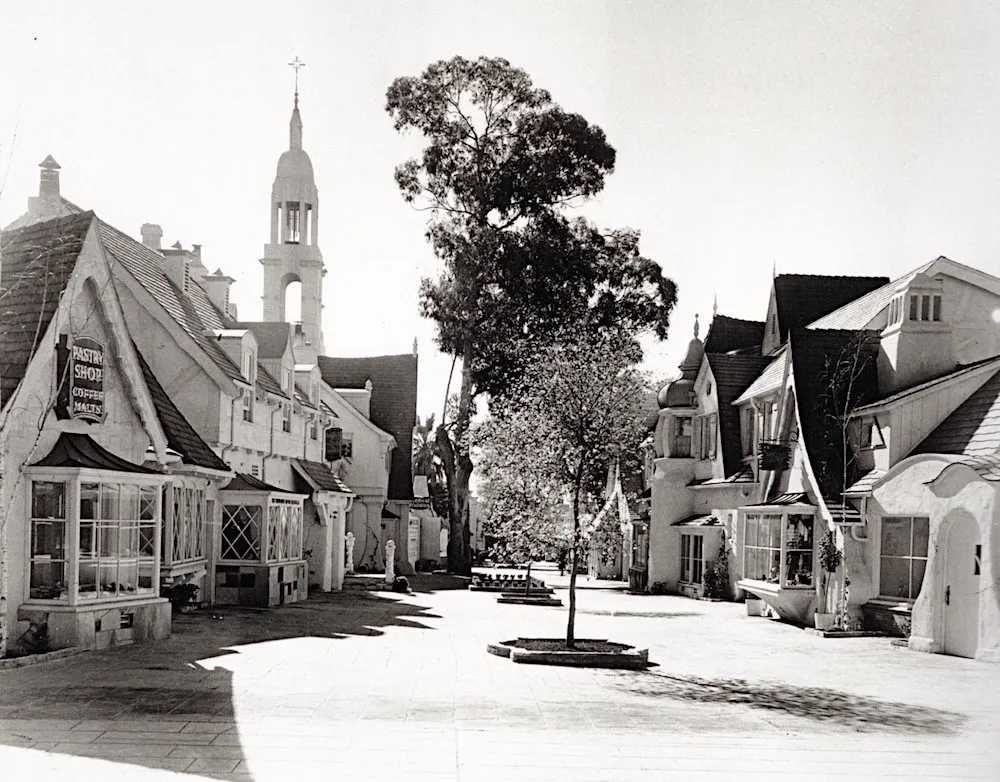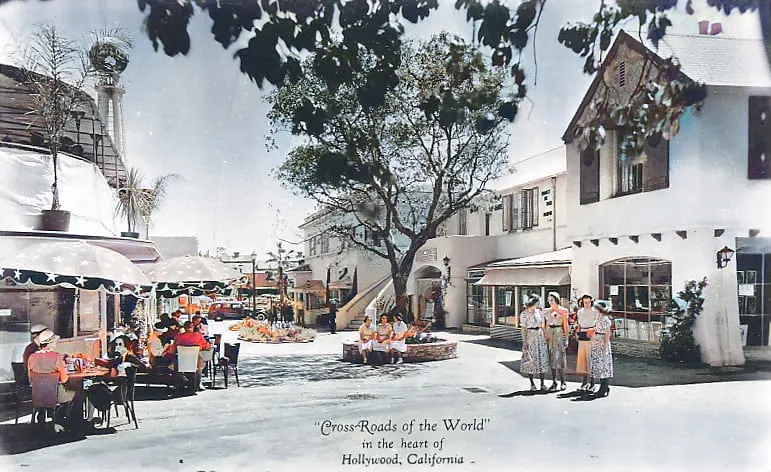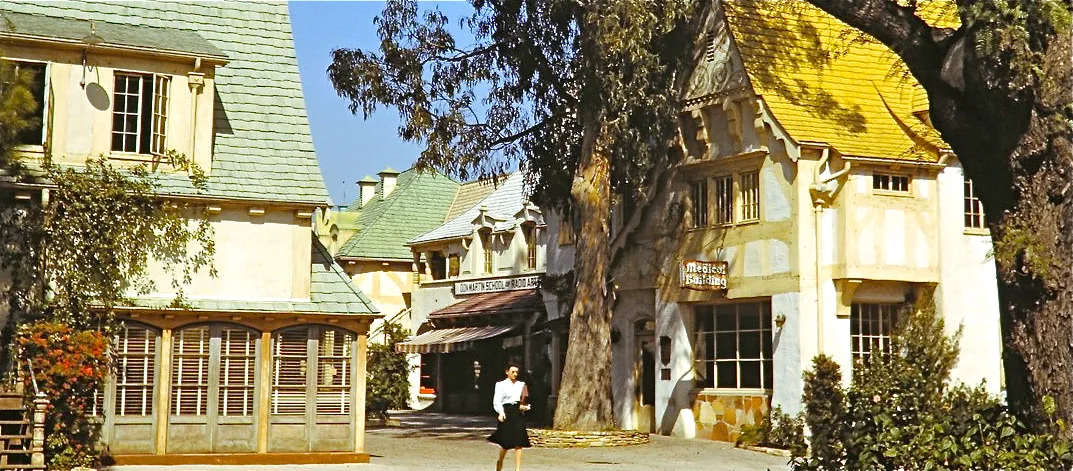The Crossroads of the World
- KP
- Feb 4, 2023
- 4 min read
In Hollywood, the Crossroads of the World intersect at Sunset Boulevard and Las Palmas Avenue. Built in 1936, the multi-national market—considered America’s first outdoor shopping mall—was designed to feel like “a permanent world’s fair with a cosmopolitan atmosphere.”

Indeed, the miniature city exudes Old World charm (Spanish Colonial, French Normandy, and English Tudor architecture) with a Moderne centerpiece: an ocean liner-shaped structure with porthole windows. At its bow, a 60-foot tower topped with a revolving globe glows in neon at night.
On the upper deck of the ship, those who worked up an appetite shopping could grab a 45-cent lunch or cocktail at the Continental Cafe & Lounge.
Along Las Palmas, Early America is represented with Cape Cod-style shingles and shutters. At the Selma Avenue entrance, there are hints of Russia (onion domes) and Arabia (keyhole arches).
The vendors matched the international setting: A Bit of Sweden cafe, Marcy de Paris perfumery, Barber of Seville, Peasant House and Garden, La Merienda tearoom, Mayfair Bag Shop, Jessie C. Ireland florals, and El Fumador de Seville cigars.
Beneath the tower, the circular commercial space was occupied by John MacSoud’s handkerchief bar, which sold imported linens from “the four corners of the world.”
Even the grand opening was treated like a world premiere, attended by a foreign “galaxy of entertainers”: Cesar Romero (Cuban-American), Boris Karloff (British), Tala Birell (Austrian), and Mischa Auer (Russian).
Five years before Crossroads of the World, the location made national headlines when underground boss Charles Crawford, whose City Hall Gang essentially ran Los Angeles during Prohibition, was murdered in his Sunset Boulevard office.

On May 20, 1931, prosecutor David H. Clark was summoned by Crawford, and according to him, asked to assist in framing the chief of police. When he refused, a gun fight broke out—and Clark mortally wounded Crawford as well as newspaperman Herbert Spencer, who he claimed had previously threatened to kill him.
Five months and two trials later, Clark was acquitted when 11 of the 12 jurors found him not guilty of murder. The lone person who voted “guilty” woke up the next morning to a bomb in their front yard.

Crawford’s widow envisioned her inherited property on Sunset Boulevard as an international market and hired architect Robert V. Derrah to make the dream a $500,000 reality. But within a few years, as World War II occupied Europe, Crossroads businesses struggled to procure their exclusive imported goods, and one by one they closed.
The shopping center transitioned to office space, and leased to tenants like Alfred Hitchcock, the Screen Actors Guild, American Airlines, and H.D. Ballenger’s literary service.

By the 1970s, the complex was at a crossroads. Neglected and deteriorating, it went up for auction, with the plan to demolish it for a high-rise building. Instead, developer Morton La Kretz, a passionate historic preservationist, purchased the property in 1977 and spent several years on its complete restoration. He also improved the clientele by leasing to book publishers, art galleries, film companies, music producers, novelists, publicists, casting agencies, and costume designers.
“It was a time when Hollywood was a ‘violent eyesore in the geographical and sentimental core of Los Angeles,’ and the community was especially vulnerable,” La Kretz told the Los Angeles Times in 1986, as the Crossroads of the World celebrated 50 years—and its placement on the National Register of Historic Places. “It was crying to be saved,” added his daughter Margaret, who helped manage the property.

Once again a Hollywood landmark, Crossroads of the World became a popular shooting location for films (L.A. Confidential, Elizabeth Taylor’s Malice in Wonderland), TV shows (Remington Steele), commercials (McDonald’s, Ford, Mercedes-Benz, Mattel), and music videos (Big Audio Dynamite’s “The Globe”).
An exact replica of the tower even popped up 2,500 miles away in Orlando, Florida, at the brand new Disney-MGM Studios in 1989. Once an information center located at the theme park’s entrance, the Crossroads of the World icon is now a gift shop.

The future of the original seems uncertain. In 2019, LA City Council unanimously approved Harridge Development Group’s proposal to construct nine buildings, including three high-rises, surrounding the historic monument (and the nearby Hollywood Reporter building).
The $1 billion project—Crossroads Hollywood: A Legacy Renewed—would add 190,000 square feet of commercial space, 2,283 subterranean parking spaces, 950 apartments, and a 308-room hotel.

Although HDG claims it wants to rejuvenate the underused area, the project has come under fire for its plan to demolish all 84 rent-stabilized apartments in the Selma-Las Palmas Courtyard Apartments, built in 1939 (City Council also voted to reject applications to landmark the property in 2018). Early in the process, residents were negotiating for temporary relocation during construction and a 36-month payout. But amid a flurry of lawsuits and setbacks, in 2020 the Crossroads Tenants Association was offered “at least $11,125,” according to TheLAndMag.com, and must vacate their homes within 120 days. (About half of the residents reportedly accepted the terms.)

In December 2021—the same month records show Crossroads SPV II LLC, aka Harridge Development Group, took ownership of Crossroads of the World and the Selma-Las Palmas Apartments—the company secured a $485 million construction loan. At the time, HDG also announced plans to break ground in 2022, with expected completion by the end of 2025.
However, as of February 2023, there seems to be no movement ... and Crossroads remains in its own world on Sunset Boulevard.
































Comments